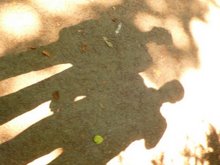What Makes Day and Night?
Lesson Plan may need to be altered for differnt grade levels.
References: ORC (http://www.uen.org/Lessonplan/preview.cgi?LPid=9571)
1: Describe how night and day are caused by the earth’s rotation
2: Explain that Earth is one of several planets to orbit the sun, and that the moon orbits Earth
Objectives:
Describe how might and day are caused by the Earth’s rotation.
Materials
Globe
Flashlight
Sticker
3 x 5 cards
Initial Observation/Demonstration:
I will ask for suggestions on what causes day and night. We will also discuss the rotation and orbits of planets around the sun. Students will hypothesize about what causes day and night as well as why the sun rises in the east and sets in the west.
Initial Model:
The Earth orbits the sun. The sun rises in the east and sets in the west (why??)
Procedure:
1. Put the sticker on the globe to indicate where you live.
2. Place the globe on a table, then turn the lights off.
3. Have a student shine the flashlight on the globe where the sticker is.
4. Ask students if it is day or night where the sticker is located.
5. Turn the globe counterclockwise until the sticker is away from you.
6. Shine the light on the other side. Students will notice the sticker is now on the
dark side, which represents night time.
There is also a second part to this experiment in which the students will learn how the Earth, sun and moon travel in relation to each other in space.
1. Divide the class into groups of three.
2. Give each group three cards and have them write “Sun”, “Moon”, and “Earth”, on the cards. Students can also draw a picture of the word they wrote.
3. Take the class outside or to a large open area.
4. Have one group come to the middle and position the sun performer. Explain that, like the real sun, he will not move. Have the child acting as Earth, revolving very slowly around the sun. Have the moon performer revolve around the moving Earth. Explain that while it takes the Earth about 365 days to orbit the sun, it takes the moon only about 28 days to orbit Earth.
Discussion/Summary:
The students will find that the counterclockwise rotation of the earth is responsible for day and night as well as the position of the sun in the sky at various times during the day. The rotation experiment will also show them the relative speed at which the Earth orbits the sun and the moon orbits the Earth.
Revised Model:
The students will understand why we have days, months and days based on the Earth’s position and rotation around the sun.
----------------------------------------------------
Name:______________________________
Date: ______________________________
Mrs. Tammy Science
Day and Night Worksheet
Directions: Follow the following directions and answer all questions with complete sentences.
1. Place a sticker on the globe where you live.
2. Shine the flashlight to the East of where you live.
3. Turn the globe slowly counterclockwise.
4. What time of day is this showing where you live?
_____________________________
5. Slowly rotate the globe counterclockwise until the light is on California.
6. What time of day is it where you live? __________________________
7. Next, pick a new place to put the sticker. Where is it? _______________
8. Shine the light on the East coast of the United States.
9. What time of day is it where your new sticker is? _____________________
10. Shine the light on your new sticker.
11. Rotate the globe counterclockwise until the light comes back onto your sticker.
12. How many hours does this take in real life? _________________
Extensions:
1. Why does it look like the sun rises in the East?
2. Where does the sun set?

No comments:
Post a Comment